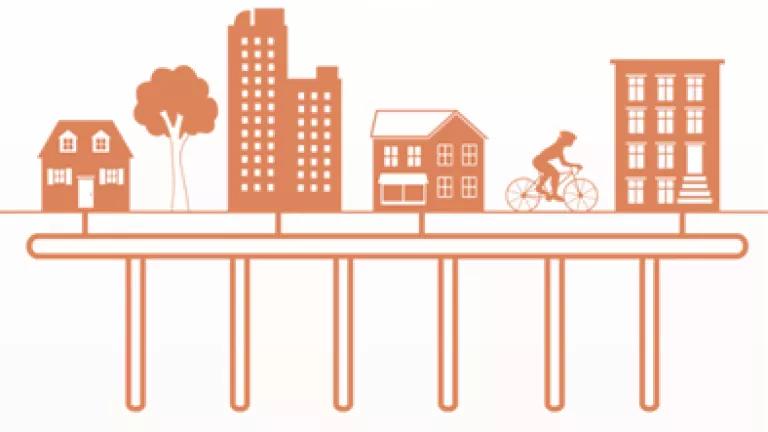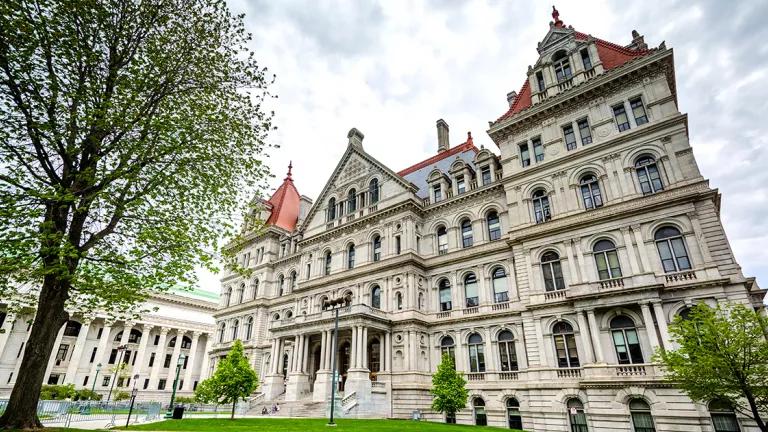
Source: HEET, 2022. This work is licensed under a Creative Commons Attribution-ShareAlike 4.0 International License.
As we dig deeper to eliminate climate-damaging Greenhouse Gas (GHG) emissions from our homes and buildings (aka building decarbonization), several state governments are exploring how to harness the earth’s natural heating and cooling powers to replace systems that burn fossil fuels to heat and cool our indoor spaces. The idea is a new spin on the home geothermal technology that has been around for decades: connecting buildings via underground pipes to a joint “thermal loop” fed by shared geothermal well fields. A variety of names are being used to describe this concept, including “district thermal” or “district loop heating.” Under the right conditions, networked geothermal can be a powerful new tool in our building decarbonization arsenal.
What is a thermal loop and how can it help fight climate change?
Deep below the ground it stays close to 55 degrees year-round. We can harness that to heat our homes in the winter when the surface is cooler and cool them in the summer, when the surface is warmer.
A district thermal system has three main components: geothermal wells, an ambient (distribution) loop, and heat pumps. Geothermal wells circulate antifreeze fluid to hundreds of feet below ground, where it gains (in the winter) or releases (in the summer) heat from the ground whose temperature is stable year-round. The fluid is then circulated through a loop a few feet below ground level to each building, where water-source heat pumps concentrate the change in temperature to provide space heating or cooling as needed. The wells and the loop are completely enclosed, with no need for added water or impact from the circulating antifreeze on soil and groundwater.
Compared to other technologies for replacing fossil fuels in homes, district thermal can provide greater efficiency, better cold weather performance, and community-scale building decarbonization (such as across an entire university campus). District thermal can increase efficiency by leveraging differing heating and cooling needs of the buildings connected to it. If one building needs heat at the same time as another needs cooling, heat could be transferred between them via the distribution loop, increasing efficiency above that of standalone geothermal heat pumps. District systems also allow for a greater variety of thermal energy sources, such as capturing the waste heat from sewer mains or bodies of water, than a standalone system might, further increasing efficiency.
District thermal can also help us decarbonize buildings at the community-wide level. Building a geothermal network provides a time and opportunity for entire campuses or neighborhoods to discontinue fossil fuel use for heating, at potentially lower cost to building owners and tenants than electrifying individually. Geothermal offers increased extreme cold-weather performance relative to air-source heat pumps due to the constant temperature underground. This is particularly true when winter temperatures drop far below five degrees and air source heat pumps begin to perform less efficiently. District thermal can help bring these cold-weather efficiencies to buildings that would otherwise be hard to electrify using other technologies, need backup heat sources, or may not have the space to install their own geothermal wells.
But our ability to deliver climate and economic benefits through networked geothermal depends on where, when, and how it is deployed. New York State and Colorado passed legislation this year that would allow public utilities to own and operate networked geothermal loops. Implementing these laws in a way that reduces energy costs and ensures public funds are spent effectively will require more research, modeling, and analysis.
What do we still need to know?
District thermal has not been widely deployed, and parameters for its siting, construction and operation are yet to be standardized. The systems will operate best when there are a variety of heating and cooling loads on the system year-round. A networked system that includes a data center that always needs cooling and a community pool that always needs heat will be more efficient than a neighborhood of homes that have roughly the same needs for heating and cooling at the same time. Gains in efficiency from a variety of thermal loads are needed to offset the cost of the extra pipes for the shared loop.
Like with all clean energy technologies, the cost and benefits of an entire system—including any related reduction of future electric grid costs—must be properly evaluated against all other decarbonization options to ensure we are installing the most cost-effective technology for each case. This will mean considering the cost of district thermal for individual building owners and society at large against air-source heat pumps, standalone geothermal, and combinations of the two. In all likelihood, the result of these cost benefit analyses will vary depending on many factors, including climate, urban density, and local heating and cooling needs.
High uptake rates among buildings that could potentially be connected to the network is also key to preventing excessive costs. If few buildings within a network footprint are connected to the system, the cost for the entire system must be split between fewer customers, potentially making the project uneconomical. How much uptake is necessary to make a project economic and will relying on voluntary connection to the network create sufficient uptake for the network to be cost effective are questions that we must answer. This is especially important when considering a district thermal system for an existing neighborhood, which would require owners to replace furnaces and air conditioners with heat pumps and potentially make other upgrades to their buildings.
Another question that needs settling is what type of pipe will be best for these systems. There are several materials that could be used for thermal loops, as well as outstanding technology questions regarding the possibility of using existing pipes that may already be in the ground. The cost implications from clearing up these questions can be significant.
Who will own and operate district thermal systems is also an open question. Unlike electricity and fossil gas, thermal energy is not yet regulated by Public Service/Utility Commissions. Lack of regulation could decrease costs relative to traditional utilities and allows for 3rd-party ownership and operation, but at potentially higher risk to customers. Like traditional electric, gas, and water utilities, thermal networks could be considered natural monopoly – the cost of building duplicate loops serving the same area may not be worth the economic benefits of market competition. Networked geothermal presents a potential new business plan for gas utilities and their workers in an increasingly carbon-free world, so we should understand the technology’s potential impact on the utility business model and in what cases utility ownership may not be as beneficial for customers as 3rd-party or municipal ownership.
As mentioned above, New York and Colorado recently passed legislation allowing gas and electric utilities to own networked geothermal systems, and Massachusetts has a pilot program of utility-owned networked geothermal systems as well. Colorado’s Governor, Jared Polis recently launched a Western Governor’s Association initiative to investigate these and many other issues related to geothermal heating, cooling, and power generation resources. Projects like the Massachusetts pilots and Governor Polis’ new initiative are excellent ways to start answering some of the important questions we outline in this blog. NRDC looks forward to engaging in these and similar processes to ensure that district thermal is used in the best interest of energy consumers, energy workers, and climate safety.



